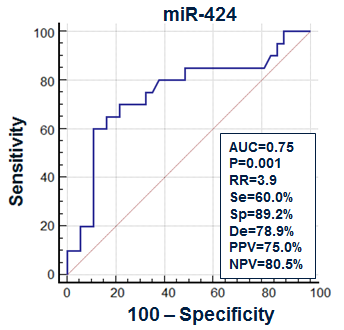
MicroRNA tests for complex diagnostic of acute rejection and bacterial infection after heart transplantation
Sofya Sharapchenko1, Olga Shevchenko1,7, Dmitriy Velikiy1, Olga Gichkun1,7, Vitaliy Poptsov2, Natalya Mozheiko3, Nina Gabrielyan4, Alex Shevchenko 5,7, Sergey Gautier6,7.
1Department of regulatory mechanisms in transplantology, Shumakov National Medical Research Center of Transplantology and Artificial Organs, Moscow, Russian Federation; 2Intensive care unit, Shumakov National Medical Research Center of Transplantology and Artificial Organs, Moscow, Russian Federation; 3Department of pathology, Shumakov National Medical Research Center of Transplantology and Artificial Organs, Moscow, Russian Federation; 4Department of endotoxicosis and purulent-septic complications, Shumakov National Medical Research Center of Transplantology and Artificial Organs, Moscow, Russian Federation; 5Department of сardiology, Shumakov National Medical Research Center of Transplantology and Artificial Organs, Moscow, Russian Federation; 6Director of Shumakov National Medical Research Center of Transplantology and Artificial Organs, Shumakov National Medical Research Center of Transplantology and Artificial Organs, Moscow, Russian Federation; 7Department of transplantology and artificial organs, Sechenov First Moscow State Medical University, Moscow, Russian Federation
Introduction: The acute rejection and bacterial infections are the main risk factors of primary graft dysfunction and high mortality after heart transplantation (HTx). The search for new minimally invasive diagnostic methods and biomarkers of graft damage is extremely relevant. MicroRNAs are widely known as small molecules, regulating gene expression. Some of them (miR-27, -101, and -424) are involved in the mechanisms of cardiovascular diseases. The aim of the study is to determine the diagnostic value of miR-27, miR-101 and miR-424 levels for early post-transplant complications – heart graft acute rejection and gram-negative bacterial infections.
Methods: The study enrolled 83 heart transplant recipients, aged 16 to 70 (48.6±10.9) years. The expression levels of miR-27, -101, and -424 were measured by PCR (Qiagen, USA) in plasma after HTx. Graft rejection was verified through morphological analysis of endomyocardial biopsy specimens; infection – through microbiological identification in blood culture.
Results: The miR-424 level didn’t differ (p=0.47) in recipients with (n=39) and without acute graft rejection (n=44), however miR-27 and miR-101 levels are significantly lower in recipients with acute graft rejection than in recipients without (p=0.01 and p=0.02 resp.). By the way the diagnostic value of miR-27 and -101 and its’ threshold value for heart transplant acute rejection was found: when miR-27 expression level is below threshold value the relative risk of acute rejection is RR=1.8 [95% CI 1.13–3.01]; miR-101 – below threshold value RR=1.9 [95% CI 1.13–3.37]. For miR-27 the sensitivity (Se) and specificity (Sp) were 53.6% and 79.2%; for miR-101 – 64.3% and Sp=70.8% resp. (Fig. 1).

MiR-27, -101 and -424 levels were determined in heart transplant recipients with bacterial infections after HTx (n=20). More than 50% of bacteria spectrum were gram-negative pathogenes: Аcinetobacter baumannii (55%), and Klebsiella pneumoniae (40%). MiR-27 and -101 didn’t differ in recipients with and without infection (p>0.05), but miR-424 level was significantly higher in heart transplant recipients with gram-negative bacteremia (p=0.02). When miR-424 level is above -5.72 fold change, the relative risk of bacteremia is RR=3.9 [95% CI 1.94–7.61]; Se=60.0%; Sp=89.2% (Fig. 2).

Conclusion: The measurement of miR-27, -101, and -424 expression levels can be used as complex tests for monitoring the risk of acute rejection and bacterial infections after HTx.
